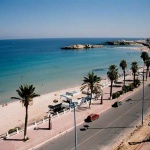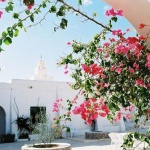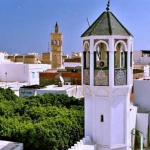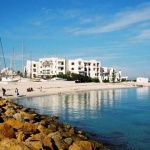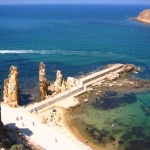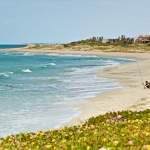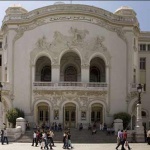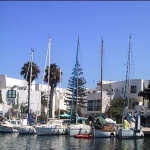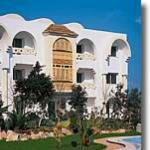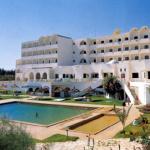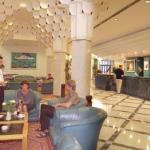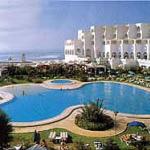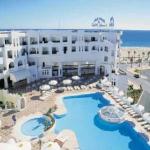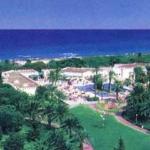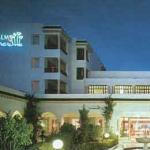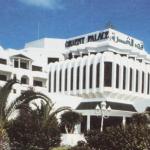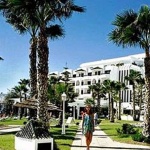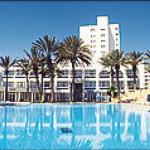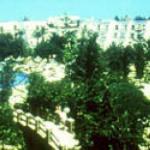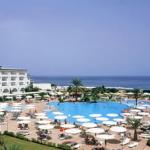Tunisia Sights
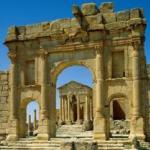 Tunisia - a relatively young tourist country in the modern sense - its intensive development began only in the 80 years of the twentieth century. But in historical terms - is one of the oldest resorts in the world - even in the times of the Phoenicians, ancient Egypt and the Roman Empire here rested members of the nobility. We Tunisia - is 1200 km. sandy beaches, hundreds of modern hotels, excellent sources of thermal waters, which built the modern spa center, as well as many historical monuments.
Tunisia - a relatively young tourist country in the modern sense - its intensive development began only in the 80 years of the twentieth century. But in historical terms - is one of the oldest resorts in the world - even in the times of the Phoenicians, ancient Egypt and the Roman Empire here rested members of the nobility. We Tunisia - is 1200 km. sandy beaches, hundreds of modern hotels, excellent sources of thermal waters, which built the modern spa center, as well as many historical monuments.Tunisia (founded in the IX century. BC. E.) - The capital (since 1956) and the country's main port, located on the shore of the lake of the same name. This is a very original city, which combines the most modern spa centers, the traditional Muslim architecture, numerous markets and excellent museums. Center of Tunisia is surrounded by walls of Medina (old city), straggling around the mosque Jami ez-Zeitouna (Zitouni, "Mosque Olive, 703 g.) - the spiritual center of the country, surrounded by numerous madrasas. The narrow streets, mosques, markets and shops of Medina - the main attraction of the city. In the upper part of Medina, near the casbah (citadel), is Area Governments, around which are institutions of state power of the country, among which the most colorful building of the Ministry of Foreign Affairs - Dar el-Bey (Bey's House).
Nearby is the Suq al-Attarin - the most exotic quarter of the city, who grew up on the site of a medieval market fragrances. Here and now sell various perfumes and spices. Preserved decorated with polychrome marble and painted palaces Dar Othman (XVII cent.) With the Museum of Applied Arts and the Dar Ben Abdallah (XVIII-XIX cc.) With the City Museum of Art and popular traditions. Among the other historic buildings attract the attention of the mosque Yusuf Bey (1616) and Hamouda Pasha (XVII century.) Mausoleum Hasanidov Turbet el-Bey Mosque and the mausoleum of Sidi Mahreza (Abu Mohammed Mahreza EU-Sadiq), Cathedral of St. Vincent de Paul, as well as the oldest building in the city - Dar al-Haddad. Medina Tunisia in 1981 has been included in the list of World Heritage UN.
One of the main attractions of the capital - the National Museum Alawneh (Bardo Museum) in the palace of Dar Hussain (Bardo), near the Tunisian Parliament - is the largest museum of the Maghreb with the world's largest collection of Roman mosaics, as well as extensive collections of archaeological finds of all ages. Public Library of the city - the biggest (after Cairo) in the Islamic world repository of Arabic literature, and the University of Tunis almost equal in age to the famous Oxford.
The central street of Tunisia, Habib Bourguiba Avenue, the picturesque, goes from the gate of Bab al-Bahar ( "French doors", XIII cent.) Medina to Lake Al-Bahir. Always worth a visit large indoor market with all the attributes of the eastern commercial life, the many small markets in the Medina, Belvedere Park, located on the territory of which the zoo and amusement park, Dah-Dah, as well as a small Salammbo Oceanographic Museum on the outskirts of the capital.
North respectable district of La Gulett, 35 km. from the capital, are the ruins of ancient Carthage (founded in 814 BC. e.) - the capital of one of the great states of antiquity. There was a center of Phoenician trading empire, which included almost all the Mediterranean trade routes converged here through the Sahara and West Asia, there thundered famous battle Punic wars and the great empire flourished. Until our days here on the slopes of the hill Beers, the ruins of the term of Antoninus Pius - one of the largest resorts of the time, second in size only thermae of Trajan in Rome, numerous Roman villas, the remains of the Capitol, an amphitheater for 50 thousand spectators, water, and 70 -km-long aqueduct which ran from the church in Carthage Water in Zigvane, the ancient cemetery on site of temples and Tanita Baala (Ammon), as well as numerous antique port facilities, which stretch along the entire coast. Most of the buildings of the ancient period severely damaged. From the later periods were the ruins of numerous Byzantine churches, the Cathedral of St. Louis (1890) in the back aisle of which is placed the National Museum, the Cathedral of St. Cyprian and the Museum Lavizheri.
You can also visit Zigvan (40 km. From Tunisia), with its ruins of the Temple of Water, a forum, the Capitol Market, the temple of Mercury and terms. To fans of Roman antiquity will be interested in a set of ruins Tuburbo-Maius with the remnants of a Roman town, forums, the Colosseum, temples, thermal baths and gymnastic halls. Called the pearl of the Tunisian town of Sidi Bou Said, whose sheltered foot of the rock houses are painted in dazzling white and blue, on top of the rock towers "Ribat" (Fortress), and from the observation deck at the lighthouse on a cliff (by the way - built from IX in the wreckage of the fort.) offers a spectacular view of the capital and its surroundings. This is a delightful place to stroll among the narrow cobbled streets lined by old stone slabs. Charming as Alexander Nevsky Orthodox Church, built by Russian sailors in 1939 (almost all of them are buried here, at the church cemetery.
Hammamet - an ancient fishing port and one of the most popular seaside resorts of the country, situated on the coast, 70 km. south-east of the capital. In place of the city in 180 AD. e. appeared Putput Roman colony, renamed later by the Arabs in Hammamet ( "bathing place"). Medina - the main historical sightseeing of the city, a quadrangular fortress on the sea shore, with the Grand Mosque (X cent.) And the market. The buildings of the city are sustained in traditional Arabic style with harmonious arches and domes, but even a pair of identical buildings are not found - each of them has its unique architectural form. Near Medina is a former tomb of Sidi Bou Hadid, as well as built using elements of ancient picturesque home of George Sebastian, in the garden, which annually hosts the International Festival of Arts. It is interesting to visit the children's amusement park "Fabilend" amusement park "1001 Nights" and a water park, or the largest golf country club - Golf Citrus, houses numerous luxury hotels among the groves and orchards, as well as spend time on the beautiful beaches of the city extending nearly 14 km. or tweak the best health centers of thalassotherapy in the country - "Bioazur", "Royal Thalassa (the largest in the Mediterranean) and" Nahraves Sentra.
In the southern part of town is a young Yasmine Hammamet resort area (or "Hammamet-Sud") - one of the largest and most modern in the country. The complex consists of several beaches, the port of Marina and the possibility of mooring up to 740 pleasure craft, well-planned embankment with many institutions, the modern Medina, children's entertainment center Karfagolend, landscaped public parks with fountains, dive centers, and numerous discos, casinos, restaurants and golf club. It offers a wide variety of marine walks and water activities.
7 km. north of Hammamet is based more in the IV. BC. e. city of Nabeul (Nabeul, a former Naples) - the center of pottery production in the country, famous, but their blue-glazed ceramic products, excellent market, Suq al-Juma, a small archeological museum, the national cuisine, wines and jagged rocky grottos coast.
On the northern coast of the country are rocky beaches, Coral Bank, surrounded by cliffs, reefs and historic ruins. Bizerte (65 km. To the north of Tunisia), famous for its magnificent forests on the slopes towering above it an extinct volcano, as well as a huge casbah (VI-XVII centuries. N. E.) Spanish Fort (1570), always noisy port small but very meaningful oceanographic museum in the premises of a small fort, the white marble Martyrs' Square, the Great Mosque (1652) with a striking octagonal minaret, a fountain, Youssef Dey (1642), picturesque Moorish houses, amazing beauty of the lake Eshkel (Garaet Ishkel, 30 km. to the south-west of Bizerte) and a wonderful fish market. Nearby is Shemtu - a relatively new archaeological site, where they were discovered the ruins of the Roman forum and theater, the ancient marble quarries and numerous buildings.
Tabarka ( "place, covered with bushes"), located at the foot of the mountain massif Krumiriya - an ancient Phoenician port in the Genoese fortress (XVI cent.), Picturesque rocks, which earned its form called "Needles", and an ideal place for diving and fishing catching. 105 km. the south-west of Tunis is the ancient Dougga (Tuggen) - the most magnificent Roman ruins of Tunis. Here in the Valley Medjerda River, discovered the arch Alexander Severus, the ruins of the Forum to the Capitol (166 AD. E.) And the temple of Saturn, the mosaic area of the Winds, a sanctuary of Juno Celeste, the beautifully preserved portico of the Capitoline temple, Punic mausoleum Atebana (III-II cc. BC. e.) terms, the House of Dionysos, House of Ulysses with beautiful mosaics (exhibited at the Museum of Bardo) and embedded into the side of the theater (188 AD. e.) for 3,5 thousand places.
Pearl Plain Sousse (140 km. To the south of Tunisia) was founded by the Phoenicians in the XI century. BC. e. under the name Hadrumet, later renamed captured it in Hunerikopolis Vandals, and Byzantines - in Yustinianpolis. Medieval monastery-fortress Ribat (IX cent.) With strong walls and 30-meter tower, the Grand Mosque and the vast catacombs (length over 5 km.) With 25 thousand graves early Christian era - the main attractions of the city. In the Museum of Roman mosaics are stored Sousa III-IV vv., Which are considered the best of the found in Africa and around the town are the remains of Phoenician tombs, Roman houses and Byzantine fortifications.
5 km. north of Sousse is a world famous resort area of Port El Kantaoui - luxury and quite modern tourist complex with a full set of facilities for entertainment and recreation - an artificial harbor marina, the Botanical Garden Oasis Park El Kantaoui with a huge collection of rare plants, water park, numerous Shopping malls, casinos, Miramar Golf, discos "Samara" and "Moroccan" Home ice cream, beer bar "Brough" with its own brewery, one of the largest in Tunisia, a golf club and a diving center and a yacht club. Nearby is the charming coastal village Ergli with majestic mosque of Sidi Bou Mendil.
"Holy City" Kairouan is situated 60 km. south-west of Sousse. Founded in 670 AD. e., Kairouan in the Islamic world is considered the fourth-holiest site after Mecca, Medina and Jerusalem. In the Maghreb countries believe that a sevenfold pilgrimage in Kairouan is equal to Hajj in Mecca. Its great mosque of Sidi Okba a forest of marble columns, brought from Carthage and powerful minaret in the form of 100-meter tower, a three-tier pyramid, is one of the masterpieces of Islamic architecture. Of interest are the burial place of the mosque with a personal barber barber Prophet Mohammed - Abu Jama al-Balawi (Sidi Zahib), the Mosque of the Three Doors (IX cent.) Cult source Bir Barut, where was found a golden cup from Mecca kayruanskie madrassas, the cemetery, where the soul Muslim goes straight to heaven, located near the city wall, irrigation pools (IX cent.) Center carpet (Kairouan is the center for the famous carpet blemishes), the National Museum of Islamic Art and the ruins of a princely palace in Rekkade.
24 km. Sousse lies south of Monastir (Phoenician Eng Penn, later - Roman Ruspenna), the ancient religious capital of Tunisia and the modern international recreation center. The main historical attraction Monastir - the remains Rabat Hartema, defensive structures in VIII., Which later became part of a powerful fortress-casbah, the gate of Bab al-Sur and Bab Al-Darby (XIII century.) Vaulted mosque (IX-X1 cc.) decorated with four domed mausoleum of the first president of independent Tunisia, Habib Bourguiba, the Museum of Islamic Art with a luxurious collection of ancient manuscripts, textiles and glass products Fatimid era, as well as the mosque of Imam Sidi Ali al-Mather on the huge cemetery KUBBA, to be buried in which is regarded by Muslims great honor. The coast is quite "boring", but the hotel swimming pool set up with the latest design and technology.
To the north of Monastir almost 6 km. stretches unbroken chain of resort hotels Skanes with a magnificent golf club and an excellent Riding School.
45 km. south of Monastir lies an ancient Punic port and the capital of Tunisia in the era of the Fatimids - Mahdia. The main highlight of the area - luxurious white sand beaches and a relatively small number of tourists. Interesting medieval Medina, the center of souvenir shops, cafes and restaurants, picturesque quay, the delightful small square Place du Cairo with octagonal minaret mosque, Mustafa Hamza (1772), Great Mosque (1965) - an exact copy built in 921 mosques, destroyed in 1554 by the Spaniards, a small mosque Slimane Hamza, the Museum of Islamic Culture, National Museum of Mahdia gate Skif El-Kala, the fortress Borj el-Kebir (XVI century.) Punic cemetery of the museum Salatka and diving centers.
The second-largest after the capital city of Tunisia - Sfax, Mahdia lies to the south, on the northern cape of the Gulf of Gabes. In this major industrial city, however, remained a lot of interesting tourist sites - the walls of Medina aglabitskoy with wide gates of Bab al-Diwan ( "Gates of the Council", XIV cent.), Jamia Mosque Al-Azuzeyn ( "Mosque of the Two Old Women", 849 g.) with a massive minaret and Sidi El-Bahri ( "Lord of the Sea"), three monumental arches, Palace of Dar Dzhelluli (XVII century.), which now houses the Museum of folk traditions, as well as the Archaeological Museum. 20 km. of Sfax is covered with palm groves archipelago Kerkenna - new and just started to develop tourist areas. On the islands of Sidi Fredzh (Ramla), Sharq (Big Kerkenna) and Gharbi (Melita), you can enjoy a secluded holiday surrounded by the cleanest sea.
Closes Gulf city of Gabes, named by the Romans Takapsa. Lying on the edge of the Great Desert, it constitutes a vast oasis of three hundred thousand trees. During the battles of the Second World War, this ancient city has lost almost all its attractions, and in our days is of interest only as a starting point for numerous tours and safaris in the Sahara desert. In the center of town lies the "heart Ueda - a pond, which gives life to the city, spread out in all directions a whole system of irrigation canals.
Island of Djerba known since antiquity. Another Odyssey, first visited the island, called it "an island lotofagov (poedateley lotus). Even today, this resort is connected with the continent of ancient Roman road. In good beach with clear water, the sights of the island is one of the oldest synagogues in the world and the place of pilgrimage for Jews from around the world - Mushrooms (VI century. BC. E.) Riyadh (where the scrolls are kept one of the oldest in the world of Torah and rests one of the authors of the Talmud - Shimon Bar Yaskhan). Also of interest are Fort Borj el-Kebir (big tower ", XIII cent.) In Houmt Suk, National History Museum in the mausoleum of Sidi Zitouni, as well as many mosques, among which are the Jamaa el-hump, Ah-Sheikh and Jamal Ettruk belonging different directions in Islam. In the labyrinth of the medina Houmt Female lie dozens of homes "Menzel" with domes in traditional Arabic architectural style, and in the coastal cliffs, as they say legends, countless hidden treasures of the legendary pirate Droguta Reis.
Inland, desert areas of the country, often no less interesting than the sea coast. 30 km. Mahdia west (210 km. south of Tunisia) is the famous El Jem (Roman Fisdrus), famous for its beautifully preserved huge Coliseum (230-238 gg. n. e., listed as a UN World Heritage Site), a height of 38 meters and a diameter of 430 m - three of its floors can hold up to 40 thousand visitors (largest - the third in the world and the first for safety). Preserved caves, which contained gladiators and wild animals. Every year from July to August in the arena of the Colosseum are festivals of classical music - acoustics of this facility is just brilliant. In El James is also a good archaeological museum with its interesting collection of Roman mosaics.
The largest city in the south of Tunisia and one of the oldest cities in Tunisia - Gafsa, in which the interest of the XV century fortress and the Grand Mosque. In the "capital of the oases, Tozeur (Tozeur) is available from the" date-markets ", one of the best in the country, the museum of Dar Sherali, mosque Blood El Hadhari (XI cent.), A labyrinth of streets of the old city Uled al Hadef, the zoo (it in the desert something!) and salt marsh sorrealisticheskim Chott El Jerid, the entire surface is covered with a layer of salt in 50 hours
Between Gafsa and Tozeur extends beautiful landscapes, including the most beautiful oases of Tunisia - Mides, Shebika and Tamerza, which was filmed more than one hundred films. To the north of Gafsa is Sbeitla (ancient Sefetula), rightly proud of the ensemble of the best preserved Roman structures in the country - a triumphal arch, the gates of Antoninus Pius, the arch of Diocletian, the ruins of the Forum and the Capitol with the temples of Jupiter, Juno and Minerva, and theater, as well as the tomb of the Christian Martyr - Bishop Yukundusa, Byzantine defensive soruzheniya and Christian churches IV-V centuries.
"Capital of the Sahara - Oil Kairouan is second only to the religious center of the country, and has 24 mosques with golden domes, many of which were built during the XV-XVI centuries. There is also a so-called "basket" - hollow in the rock, giving rise to many purest artesian springs that give life a waterless desert.
"The gate of the desert" - Douz, is surrounded by dunes of the desert and is famous for its tradition of care we save, "Festival of the Sahara, the traditional market and their date-groves (say here, more than 800 thousand date palms). Of the Dusan you can go for many days journey across the Sahara, to visit the area of Al-Hofra which converge stone and sand desert, or visit the unique mountainous region of Matmata (400 km. To the south of Tunisia), where lie the most "wild" landscapes, where they filmed "Star Wars" Lucas and where there are ancient rock settlement of the country. Throughout the area are spread dozens of fortified settlements, castles "Ksar" and Berber settlements, such as Medenine, metamere, Dzhuama, Tabarka, Duire, Shenin or Germessa.
